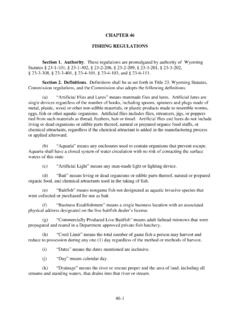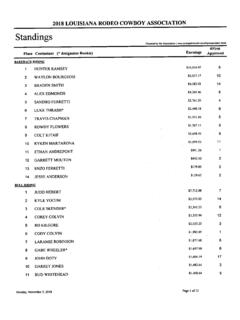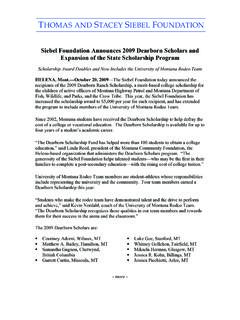Transcription of b State Species Abstract a - Wyoming
1 Wyoming Species Account Page 1 of 8 Black-tailed Prairie Dog Cynomys ludovicianus REGULATORY STATUS USFWS: Listing Denied USFS R2: Sensitive USFS R4: No special status Wyoming BLM: Sensitive State of Wyoming : Nongame Wildlife; Pest CONSERVATION RANKS USFWS: No special status WGFD: NSS4 (Cb), Tier II WYNDD: G4, S2S3 Wyoming contribution: MEDIUM IUCN: Least Concern STATUS AND RANK COMMENTS Black-tailed Prairie Dog (Cynomys ludovicianus) has a complicated history with the Endangered Species Act (ESA) involving several petitions, decisions, litigations, and re-decisions, beginning with a petition to list the Species as Threatened or Endangered in 1994. The latest official action was a 2009 decision by the Fish and Wildlife Service that listing was not warranted under the ESA 1. The Wyoming Natural Diversity Database has assigned Black-tailed Prairie Dog a range of State conservation ranks because of uncertainty regarding the severity of threats and intrinsic vulnerability in Wyoming .
2 NATURAL HISTORY Taxonomy: Mammalogists currently recognize five Species of prairie dog, all within the Genus Cynomys and all restricted to North America 1, 2. Black-tailed Prairie Dog is the most widely distributed of all, occupies the Great Plains proper, and shares range boundaries with the White-tailed Prairie Dog (C. leucurus) and Gunnison s Prairie Dog (C. gunnisoni) to the west. None of the Species apparently hybridizes with any other. Some scientists recognize two subspecies of the Black-tailed Prairie Dog C. ludovicianus arizonensis and C. ludovicianus but others recognize only one form. If subspecies are valid, C. l. ludovicianus would be the only subspecies found in Wyoming 3, 4. Description: Black-tailed Prairie Dog is identifiable in the field. It is a large (adult total length 370 mm, weight 820 g) ground squirrel with a robust, stocky body and short legs. Pelage is buff brown, and the tail is tipped with black.
3 Black-tailed Prairie Dog almost always occurs in social groupings marked by high densities of individuals and many conspicuous burrow entrances. The black-tipped tail distinguishes Black-tailed Prairie Dog from the otherwise similar White-tailed Prairie Dog, and its large size distinguishes it from other ground squirrels (Urocitellus, Wyoming Species Account Page 2 of 8 Xerospermophilus, and Ictidomys) whose adults reach only ca. 75% of the total length and < 50% the weight of Black-tailed Prairie Dog 5. Distribution & Range: Historically, Black-tailed Prairie Dog occupied short- and mixed-grass prairie from southern Saskatchewan to northern Mexico and from the front ranges of the Rocky Mountains east to about the current Nebraska/ Iowa border. It is estimated that occupied range has declined by > 95% relative to historic levels 1, 3. Although that estimate has been challenged, it is generally accepted that the Species has undergone major declines in abundance and occupied area within its historic range boundaries 5, 6.
4 Black-tailed Prairie Dog still occurs across most of its historic range, but does so now as a scattering of small and highly-segregated colonies as opposed to its more continuous former pattern. This appears to be the case within Wyoming as well, with colonies of various sizes and insularities extending from the State s eastern border west to the Laramie and Bighorn Mountains 5, 7. Black-tailed Prairie Dog overlaps with White-tailed Prairie Dog along a ca. 60 km-wide zone running roughly between the towns of Casper and Kaycee, Wyoming 5. The Species is not known from the Bighorn Basin, although there are reports of a small, human-introduced colony west of the town of Cody, Wyoming existence and current status of such a colony is unknown. Habitat: Black-tailed Prairie Dog is found in short to mid-grass prairies on flats or shallow slopes. Such environments are likely preferred because they provide abundant food (grasses and forbs; see Diet) as well as long sight distances for predator detection 4.
5 Persistent grazing by Black-tailed Prairie Dog maintains short vegetation on and near occupied colonies 4, 8. Shrublands and tall grasses are avoided 3, 9. Black-tailed Prairie Dog additionally prefers fine, non-sandy soils that can hold burrows, as it lives in extensive self-dug burrow systems year-round. The Species is commonly referred to as a keystone Species because of the suite of effects it has on occupied grasslands: the concentration of prairie dogs themselves in an occupied colony provides reliable prey for predators such as Black-footed Ferret (Mustela nigripes) and Ferruginous Hawk (Buteo regalis); prairie dog burrows are used as cover by many other vertebrate and invertebrate animals; and infiltration of air, water, feces, and other biomass into the soil profile via burrows can increase long-term site productivity 10. Phenology: Black-tailed Prairie Dog breeds from February to March. Most individuals first breed in the second winter following their birth, with a few breeding in the first winter.
6 Litters of 1 8 pups are born about 5 weeks after breeding. Young remain underground for 5 7 weeks, then emerge and begin independently feeding on vegetation. Juvenile males disperse from their natal burrow system at about 1 year of age. Adult males also relocate to a new burrow when daughters become mature. Females tend to remain in or near their natal burrow for life. Black-tailed Prairie Dog does not hibernate, but will undergo periods of temporary torpor during especially cold winter episodes 2, 4, 11. Diet: Black-tailed Prairie Dog is strongly herbivorous, feeding on stems, leaves, seeds, and roots of a variety of plants. Prickly pear cactus (Opuntia spp.) pads and roots are a major food source in the winter 2, 3. Occasional eating of insects is reported, but the degree to which this occurs or is needed to fill particular nutritional gaps is unknown. Wyoming Species Account Page 3 of 8 CONSERVATION CONCERNS Abundance: Continental: WIDESPREAD BUT PATCHY Wyoming : ABUNDANT A range-wide survey completed in 2015 estimated 1,932,826 acres of potential Black-tailed Prairie Dog colonies across all 11 states currently occupied.
7 After adjusting for errors of commission, Wyoming is estimated to contain 2,505 active black-tailed prairie dog colonies (90% CI: 2,356 2,656), totaling 216,166 acres (90% CI: 199,776 242,419). Of those colonies, 18 (90% CI: 11 26) were > 1,000 acres each and totaled 33,389 acres (90% CI: 20,826 52,051) combined 7. Population Trends: Historic: LARGE DECLINE Recent: MODERATE DECLINE Rangewide assessments suggest that in the early 1900s Black-tailed Prairie Dog numbered in the billions, covering > 30 million ha 3. Large declines have occurred since then due to habitat conversion, deliberate eradication via poisoning and other methods, and disease 6, 12. Epizootics of sylvatic plague an exotic disease caused by the bacterium Yersinia pestis and carried by fleas is thought to have continued the decline of the Species into recent decades 13. By 1997, Black-tailed Prairie Dog numbers had decreased by an estimated 98 99% from their historic levels 1, 3, although that estimate is debated 5, 6.
8 Similarly, occupied area in Wyoming is estimated to have decreased by > 80% from historic levels 14, although determining the precise level of long-term statewide decline is problematic 6. Even though recent State -wide surveys have utilized different techniques, results suggest little change in total occupied acres since formal surveys were initiated in 2003 7, 15-17. Intrinsic Vulnerability: MODERATE to HIGH VULNERABILITY Black-tailed Prairie Dog is very susceptible to sylvatic plague, which can kill up to 95% of prairie dogs in infected colonies 13, 18. Plague outbreaks in prairie dogs can occur anywhere in Wyoming , and the flea-borne pathogen persists in many common mammal Species between outbreaks. Although Black-tailed Prairie Dog has the ability to disperse up to 5 km, individuals rarely disperse beyond their natal colony. Low dispersal rates may make it difficult for Black-tailed Prairie Dog to colonize new sites 3, 4.
9 Extrinsic Stressors: MODERATELY STRESSED Sylvatic plague appears to be a constant threat to Black-tailed Prairie Dog as it persists in fleas infecting a range of common mammals throughout the State . Also, Black-tailed Prairie Dog is classified as a pest Species in Wyoming , making lethal control activities legal 1. Common control methods include poisoning and shooting, with the latter pursued for recreation as well as control. When used locally and intensively, both have the potential to remove whole colonies of Black-tailed Prairie Dogs 19, 20. Conversion of grassland to cropland, urban/exurban development, and industrial infrastructure can threaten Black-tailed Prairie Dog, although these land conversions are relatively uncommon in Wyoming compared other parts of the Species range 3. Energy-related development is increasing in some portions of Black-tailed Prairie Dog range in Wyoming , but it is unknown how energy development specifically affects the Species .
10 Wyoming Species Account Page 4 of 8 KEY ACTIVITIES IN Wyoming In 1998, the Interstate Black-tailed Prairie Dog Conservation Team was formed in response to a potential petition for protection of the Black-tailed Prairie Dog under the ESA. The team developed a multi- State conservation plan which provided management guidelines and goals for states 21. As part of this plan the Wyoming Game and Fish Department (WGFD) has utilized multiple survey techniques, including digitizing colonies from NAIP imagery and aerial surveys, to monitor distribution and area of Black-tailed Prairie Dog colonies every 3 6 years 15-17. The latest in this series of surveys was completed in 2015 as part of a range-wide survey effort. The survey provided not only the most recent estimates of distribution and size of colonies, but also developed a survey protocol and sampling scheme that can be used by wildlife managers in all states within the Species range 7.














